60. Afghan Hound
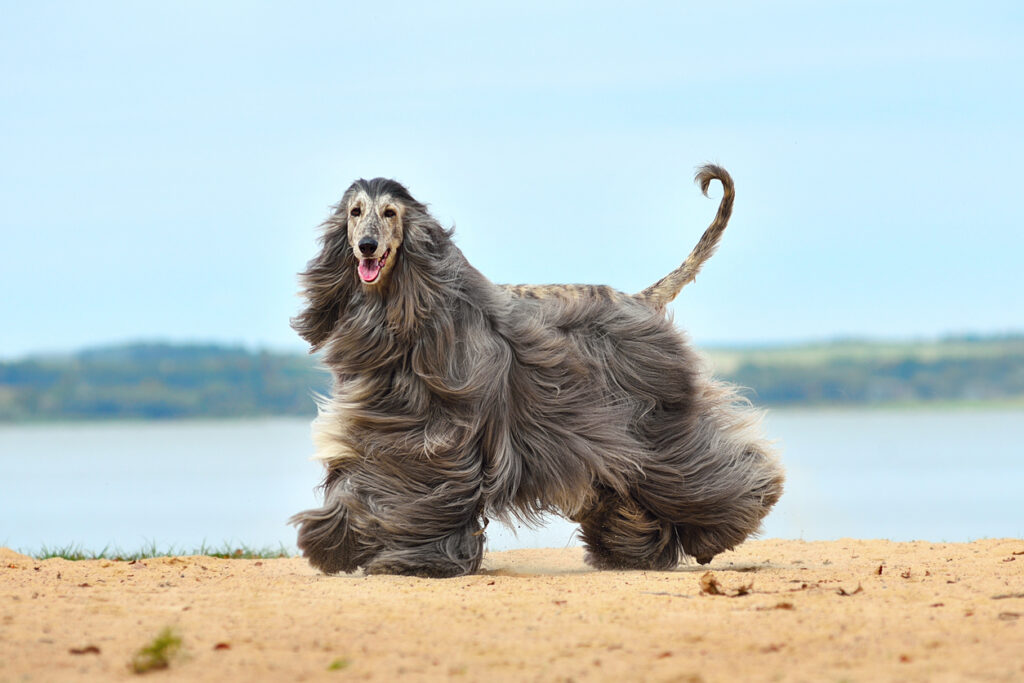
The Afghan Hound is the supermodel of the dog world, elegant, aloof, and utterly uninterested in your need for obedience. Ranked dead last at #60 in working intelligence, this ancient breed was developed to hunt game across the mountainous terrain of Afghanistan, often miles ahead of their handlers. That independence is still hardwired in. With top speeds reaching 40 mph and a gaze that suggests they’re pondering something far more interesting than “sit,” Afghans are built for self-reliance, not drills.
Their flowing coat and aristocratic posture hide a surprisingly agile, durable dog, but they’ll only cooperate when it feels worth their time. That doesn’t mean they’re unintelligent; it means they prefer decisions over commands. One Afghan named Snuppy was the first dog ever cloned, chosen by scientists not for obedience, but for genetic legacy. If you want a dog that thinks like a cat with runway presence and ancient instincts, the Afghan Hound is your low-key genius in a silk robe. Source: Psychology Today – Coren’s Dog Intelligence Ranking
59. Basenji
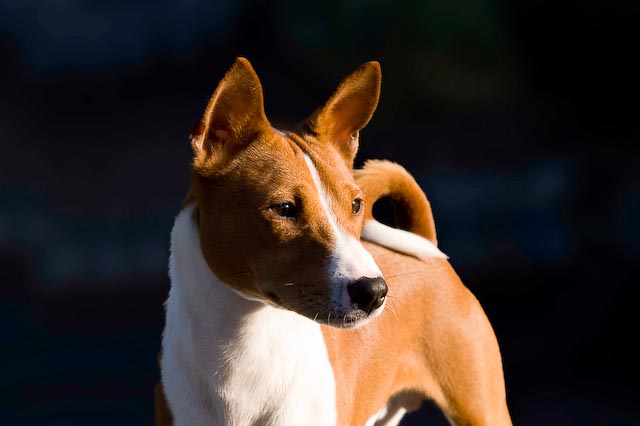
The Basenji is proof that silence can be strategic. Ranked #59 in obedience intelligence, this barkless African breed was designed to hunt in dense jungle terrain, relying on sharp sight, high-speed reflexes, and independent judgment. Their intelligence isn’t about listening, it’s about calculating. Basenjis operate with feline self-assurance: they size you up, assess the payoff, and decide if it’s worth their time. With lean builds (20–25 pounds) and lightning agility, they’ve been clocked at speeds up to 25 mph and can scale fences like they’re auditioning for Cirque du Soleil.
While they may ignore your commands, they’re experts in pattern recognition and logic-based problem-solving. One Basenji named Tanzie made headlines for easily opening drawers, doors, and food bins. Their minds are always working, it’s just not in service of obedience. For those who want a dog that respects autonomy (mostly their own), the Basenji is less a pet and more an exotic, emotionally distant roommate with a killer vertical leap. Source: American Kennel Club – Basenji
58. Bulldog
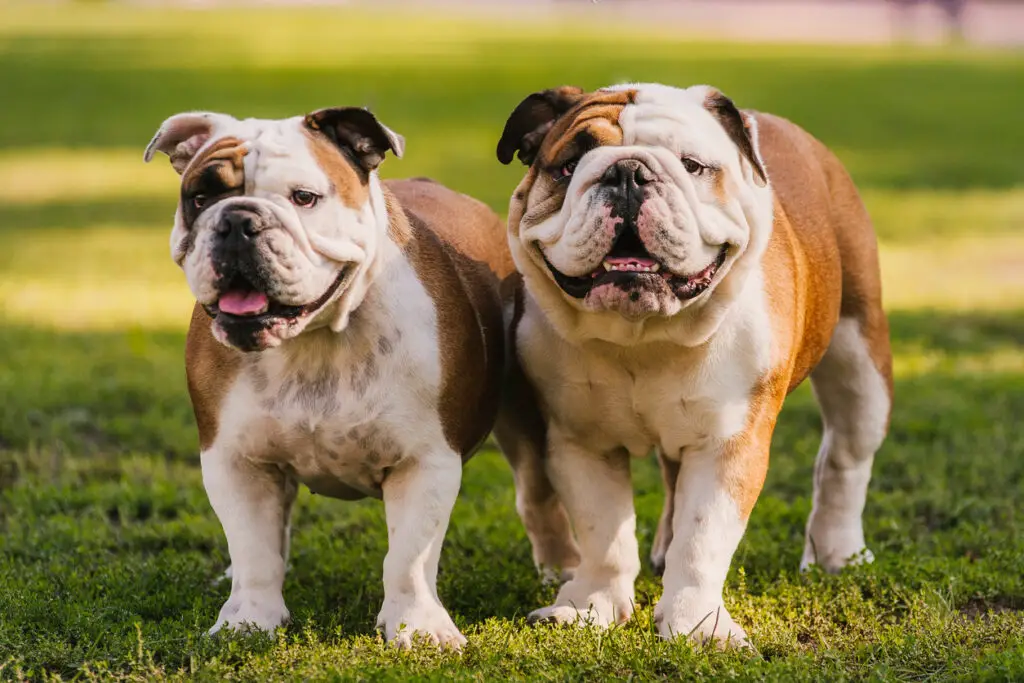
The Bulldog is that low-key friend who looks like they’re about to nap and probably are, but don’t let the droopy face fool you. Ranked #58 in obedience intelligence, Bulldogs aren’t slow learners; they’re just deeply committed to doing things on their terms. Originally bred for bull-baiting, their fearless roots have mellowed into stubborn charm. At 40 to 50 pounds with a thickset body and a signature underbite, they’re likelier to sit down and grunt at you than jump through hoops unless the hoop contains snacks.
Bulldogs excel at emotional manipulation. They’re surprisingly sensitive, often in tune with your voice’s tone and the household’s rhythm. But they’re also masters of selective hearing, and their idea of problem-solving frequently involves staring you down until you cave. They can learn commands, but they need a reason to care, and a strong whiff of bacon usually helps. This dog doesn’t aim to impress; it expects to be adored. Source: American Kennel Club – Bulldog
57. Chow Chow
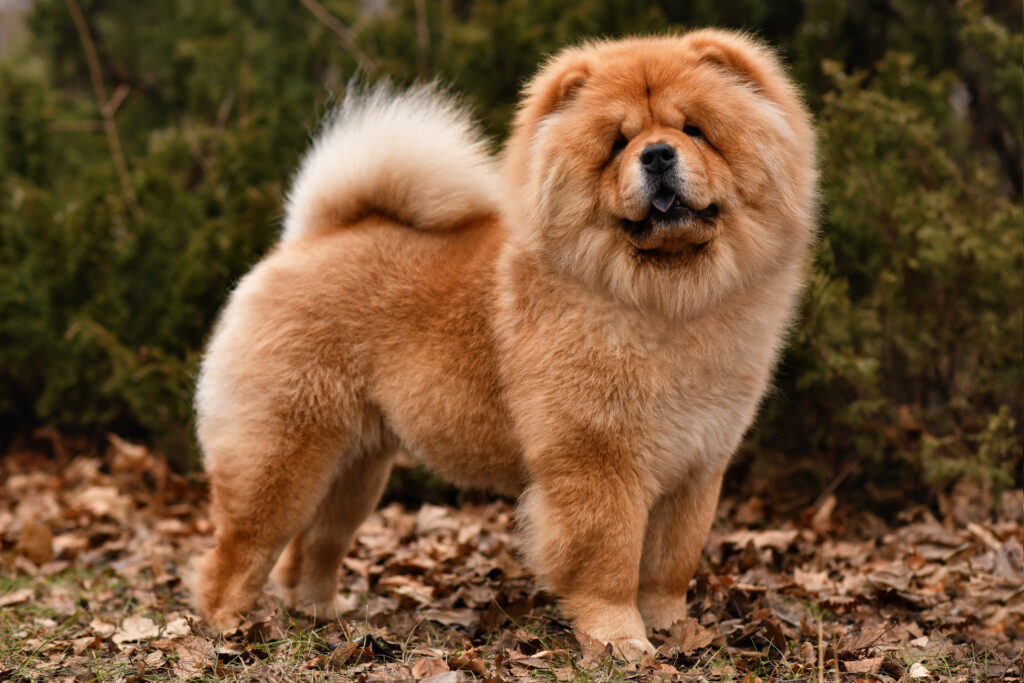
The Chow Chow walks into a room like it owns the deed. Ranked #57 in obedience intelligence, this ancient Chinese breed isn’t here to perform; it’s here to observe, judge, and maybe bless you with its attention. With roots dating back over 2,000 years, Chow Chows served as guardians, cart-pullers, and even hunting dogs for Chinese nobility. Their bear-like appearance, blue-black tongue, and dense double coat (sometimes topping 70 pounds) make them one of the most distinctive breeds in the world, but their personality is even more unique.
They learn commands at a slower pace, often requiring 40 to 80 repetitions to retain a new cue, but that’s not because they’re slow. It’s because they question everything. They weigh your tone, the room, the reward, and whether they respect you enough to bother. Once they do, they rarely forget. Chows are intensely loyal to their families and deeply suspicious of strangers. They’re not eager-to-please pets; they’re more like the fabulous, distant mentor in a kung fu movie, quiet, calculated, and not to be underestimated. Source: American Kennel Club – Chow Chow
56. Borzoi

The Borzoi is elegance in motion and independence in mindset. Ranked #56 in obedience intelligence, this Russian sighthound was bred by nobility to chase wolves and hares across frozen plains, using speed, vision, and instinct rather than commands. Often topping 100 pounds and reaching speeds of 35 to 40 mph, Borzois are built like greyhounds in fur coats, capable of covering vast ground with long, silent strides. Their brains are wired for visual tracking and split-second decisions, not repetitive obedience drills.
Borzois typically take longer to respond to commands and may require up to 80 repetitions to learn new ones, but that’s because they were designed to work without constant direction. They watch, calculate, and act when they believe it’s necessary, not before. In home life, they’re quiet, refined, and often aloof with strangers. Their intelligence is spatial and situational, best revealed when they’re in motion, reading terrain, predicting prey, and adjusting mid-stride like a four-legged chess master. If obedience is a test of loyalty, the Borzoi prefers to pass with style or not at all. Source: Vetstreet – Borzoi
55. Bloodhound

The Bloodhound isn’t here to heel, it’s here to hunt, track, and follow a scent across three states if necessary. Ranked #55 in obedience intelligence, this ancient breed traces its origins back over 1,000 years to monasteries in France and Belgium, where it was developed to follow scent trails over long distances and rugged terrain. With a weight range of 80 to 110 pounds and a scent receptor count nearing 300 million (compared to a human’s 5 million), the Bloodhound is the undisputed king of the canine olfactory world.
While they may require 80+ repetitions to perform a command reliably, their scent-tracking ability is unparalleled. They’ve been known to follow week-old trails across more than 130 miles, and their findings are admissible in U.S. courts. Their long ears and droopy skin serve a purpose: they stir up and trap scent molecules as the dog moves. Obedience? Not their strength. But if you go missing in the woods, you’ll want a Bloodhound on the trail, and they won’t stop until they find you. Source: PetMD – Bloodhound
54. Pekingese
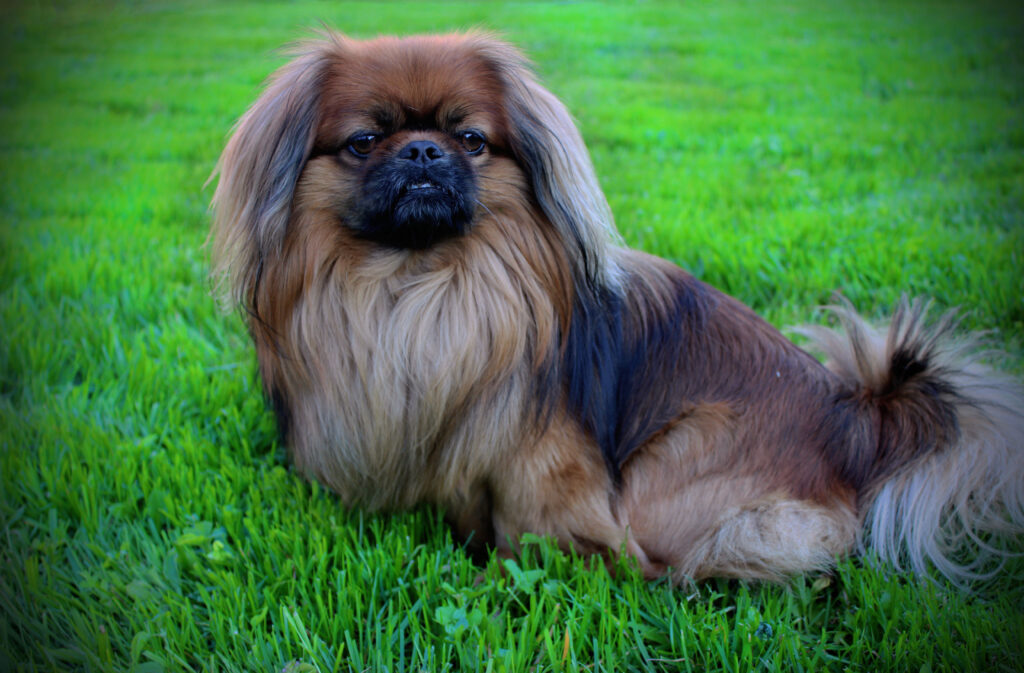
The Pekingese doesn’t do tricks; it holds court. Ranked #54 in obedience intelligence, this toy breed was bred exclusively for Chinese imperial royalty, where it was carried in silk sleeves, guarded by eunuchs, and treated as a sacred creature. Weighing just 7 to 14 pounds, the Pekingese was never expected to herd, fetch, or follow commands; it was expected to be admired. That royal heritage is deeply ingrained: they don’t respond to authority unless earned, and even then, only when it aligns with their interests.
Their stubbornness masks a sharp, observant mind. Pekingese have been known to watch, wait, and respond with unexpected timing, often acting only when the reward is worth it. They may take dozens of repetitions to master a command, but they rarely forget it once learned. In ancient China, stealing a Pekingese was punishable by death. Today, they’re more likely to rule the living room than the palace, but don’t tell them that. They’re still convinced they’re the emperors of everything they survey. Source: Royal Canin – Pekingese
53. Beagle

The Beagle may have floppy ears and a puppy-dog stare, but don’t mistake that this scent hound has its own agenda for submission. Ranked #53 in obedience intelligence, the Beagle was bred in England for pack hunting, following scent trails for miles with relentless determination. With around 225 million scent receptors and a weight range of 20–30 pounds, Beagles are compact detectives. Their strong-willed nature often shows up in training sessions where they’d rather chase a smell than sit for a treat.
Beagles require 70–80 repetitions to lock in a command, not due to lack of brains but because they prioritize sensory input over human instructions. They’ve been employed in some of the most scent-reliant jobs around. For example, the USDA’s Beagle Brigade inspects luggage at airports to detect prohibited agricultural products, often with better accuracy than machines. They’re emotional, curious, and loud (expect baying, not barking), and their intelligence is best respected, not tested. Source: U.S. Department of Agriculture – Beagle Brigade
52. Mastiff (English Mastiff and Bullmastiff)
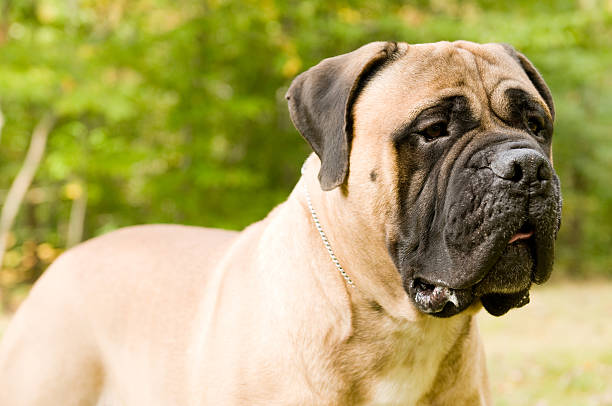
The Mastiff is a massive monument of muscle, drool, and deliberate thought. Ranked #52 in obedience intelligence by Stanley Coren, this ancient breed group, especially the English Mastiff and Bullmastiff, is known for its slow, thoughtful demeanor rather than lightning-quick obedience. The English Mastiff can weigh up to 230 pounds and was once used to guard estates and castles. The Bullmastiff, slightly smaller and bred from Bulldogs and Mastiffs in the 19th century, was developed to apprehend poachers without excessive violence.
Both breeds require 40–80 repetitions to master a command, not due to lack of smarts, but because they prefer calm observation over instant reaction. Their intelligence lies in judgment, loyalty, and physical presence. These dogs are famously devoted, lazy, and surprisingly gentle with family. Look elsewhere if you need a dog that comes running every time you call. Do you need one that thinks before it moves and stands like a boulder when it matters? You’ve found your giant. Source: Mastiff Club of America
51. Basset Hound

The Basset Hound is the Sherlock Holmes of the scent world, with the attention span of a tired toddler regarding obedience. Ranked #51 in obedience intelligence, this French-born breed was designed to trail small game like rabbits through dense brush, using one of the most powerful noses in the canine kingdom. With over 220 million scent receptors and a low-slung, 50–65 pound body, Bassets can track scents across vast distances but may ignore verbal commands mid-sniff like they’re tuning out background noise.
Their droopy eyes and lumbering gait hide a stubborn, single-minded intelligence. They’re excellent at puzzle-solving when food or scent is involved, and they remember routines with surprising clarity, but they’ll take their sweet time responding. In one study, Bassets showed high retention for scent-based cues but poor performance in timed response tasks. They know what you’re asking, they’re just thinking it over while sniffing something more interesting. Source: VCA Animal Hospitals – Basset Hound
50. Shih Tzu
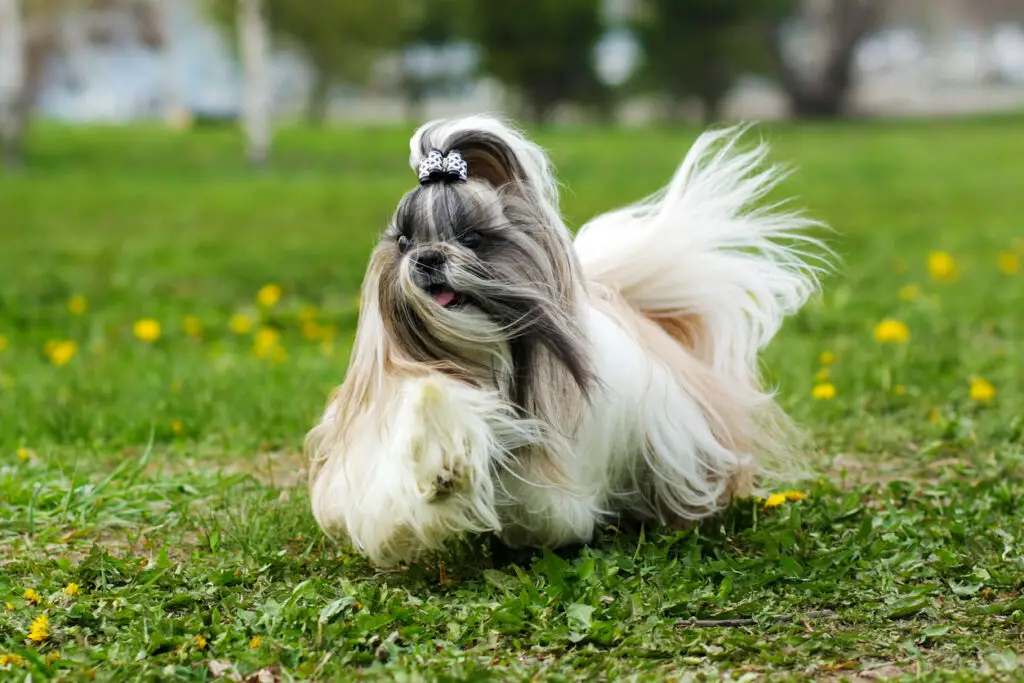
The Shih Tzu was bred to be admired, not managed. Ranked #50 in obedience intelligence, this ancient Chinese lapdog once lounged in imperial palaces, serving as a living ornament to royalty. Weighing between 9 and 16 pounds and draped in a flowing coat of silk-like fur, the Shih Tzu isn’t naturally inclined toward sit-stay drills. They’re not incapable; they have priorities, and those rarely involve repeating tricks for your amusement. Their lineage includes Tibetan sacred dogs, and they often carry themselves like they still belong in a palace.
Despite their reputation for being stubborn, Shih Tzus are pretty perceptive. They learn routines quickly and pick up on tone and emotion with ease. However, training requires patience, creativity, and an understanding that they respond best to play and praise, not pressure. One study found that while they were slower in obedience trial metrics, they performed well in memory-based and adaptive learning tasks. Don’t expect them to chase tennis balls; they’d rather watch you do it. Source: Shih Tzu Club UK
49. Great Pyrenees

The Great Pyrenees doesn’t follow orders; it follows instincts honed over centuries of solitary mountain duty. Ranked #49 in obedience intelligence, this majestic breed hails from the Pyrenees Mountains between France and Spain, where it was tasked with guarding sheep from predators like wolves and bears, often without human supervision. Weighing 85 to 160 pounds and equipped with a thick, weather-resistant coat, the Pyrenees was bred for stamina, independence, and calm judgment. They’re still evaluating whether your command makes sense if they don’t obey immediately.
While they may take 70+ repetitions to lock in a command, they’re incredibly reliable once trained and rarely forget. These dogs are deeply protective, especially with children, and will instinctively place themselves between their family and perceived threats. One Pyrenees named Duke famously protected a flock of over 100 sheep in Montana through two wolf attacks, on his own. They may not sit on cue, but they’ll stand guard through a snowstorm without being asked. Source: Great Pyrenees Club of America
48. Scottish Terrier
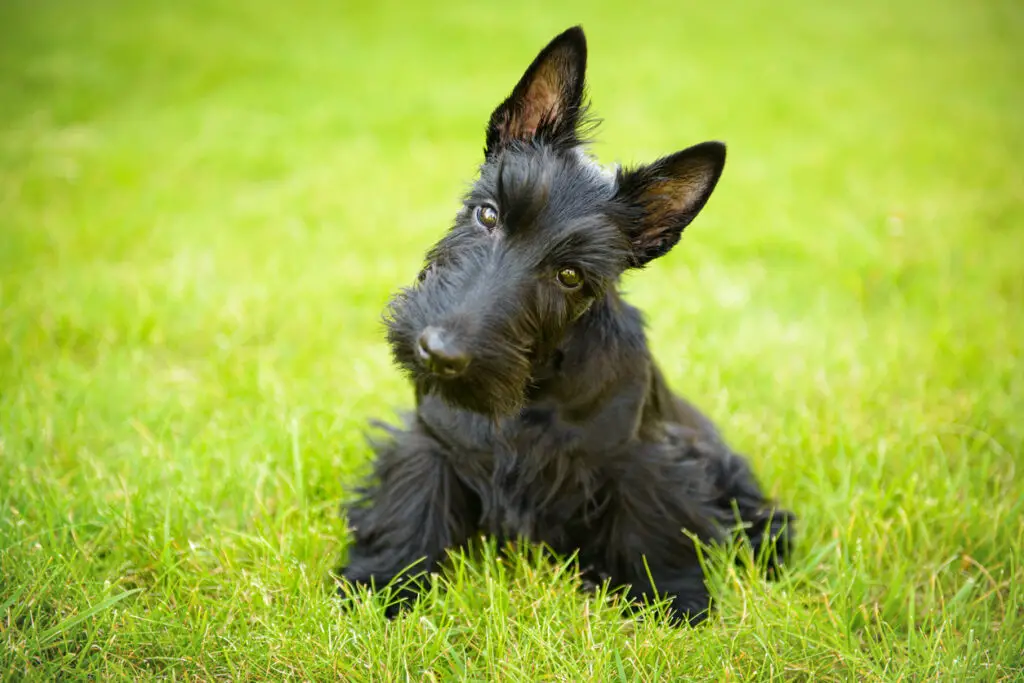
The Scottish Terrier is a dignified, little, compact, stubborn, and fiercely independent powerhouse. Ranked #48 in obedience intelligence, this breed was developed in the Scottish Highlands to hunt foxes and badgers, which meant going solo into underground dens. At around 18 to 22 pounds, Scotties are low to the ground but high on self-assurance, with a wiry coat, piercing eyes, and an attitude that practically comes with a monocle.
Training a Scottie takes patience and a sense of humor. They typically require 40–80 repetitions to master a command and prefer working on their terms. That said, they have a sharp memory, strong problem-solving skills, and an uncanny ability to observe and assess. President Franklin D. Roosevelt’s famous Scottie, Fala, had his own press clippings and fan base, and that legacy of brainy stubbornness continues today. Scotties aren’t here to please you. They’re here to run your house like a highland estate. Source: Scottish Terrier Club of America
47. Saint Bernard

The Saint Bernard is the gentle colossus of the Alps, massive in size, slow to react, but intensely dependable when it counts. Ranked #47 in obedience intelligence, this breed was developed by monks at the Great St. Bernard Pass between Switzerland and Italy to locate lost travelers in snowy terrain. Weighing anywhere from 120 to 180 pounds and equipped with a powerful nose and an unflappable temperament, Saint Bernards may not ace obedience drills quickly, but they were bred to make critical decisions without constant guidance.
These dogs are famously patient and have a strong emotional radar, especially with children. Their legacy includes Barry, a Saint Bernard credited with saving more than 40 lives in the early 1800s, navigating avalanches and icy cliffs. They may need 50+ repetitions to learn a formal command, but once they understand a task, they execute it with quiet resolve. You won’t get snappy precision, but you’ll earn loyalty, calm under pressure, and the ability to carry a small person out of a blizzard if it ever comes to that. Source: American Kennel Club – Saint Bernard
46. Lhasa Apso

The Lhasa Apso may look like a pampered lapdog, but its roots are as ancient and watchful as the Tibetan monasteries it once guarded. Ranked #46 in obedience intelligence, the Lhasa Apso was bred not to fetch or herd but to alert monks to approaching danger, relying on sharp hearing, independence, and an innate sense of suspicion. Weighing between 12 and 18 pounds and coated in a flowing mane of dense hair, it moves with a regal air that says, “I see everything, and I’ll act when I’m good and ready.”
Training a Lhasa requires patience and a bit of humility. These dogs may need 40 to 80 repetitions to master a command, but once learned, it’s locked in for life. Their intelligence lies in selective loyalty and environmental awareness. They’re not performers, they’re sentinels. While they won’t jump through hoops to please, they’ll stand guard at your feet like a stubborn little lion with a long memory and a serious attitude. Source: American Lhasa Apso Club
45. Chihuahua

Small in size, big in attitude, and unbothered by your expectations, the Chihuahua ranks #45 in obedience intelligence. Weighing just 3 to 6 pounds, this ancient Mexican breed descended from the sacred Techichi dogs of the Toltecs and was never meant to herd sheep or retrieve game. It was designed to be alert, expressive, and fiercely loyal. Chihuahuas tend to learn commands more slowly in formal settings (requiring 40–70 repetitions), but their intelligence lies in their emotional sharpness and survival smarts.
They read human behavior like a well-annotated script and often shape their routines based on yours. Chihuahuas have been known to recognize dozens of specific words, detect changes in tone, and alert their humans to visitors long before the doorbell rings. They’re also notoriously brave, standing their ground against dogs ten times their size, sometimes foolishly. If your idea of smart is obedience, the Chihuahua might not top your list. But if it’s about perception, memory, and defiant independence? These little dynamos are in a class of their own. Source: PetMD – Chihuahua
44. Chinese Crested

The Chinese Crested is part dog, part drama queen, and entirely unbothered by your commands. While not officially ranked in Stanley Coren’s original obedience intelligence list, the breed is widely considered to fall in the same learning tier as the Lhasa Apso or Shih Tzu, requiring 40–80 repetitions to master a command and responding with a hefty dose of personality. Weighing 8 to 12 pounds, they come in two unforgettable varieties: the Hairless (tufted ears, mohawk, and booties) and the Powderpuff (soft, full coat). Both are affectionate, alert, and more emotionally intelligent than obedient.
Cresteds are experts at reading their humans and reacting to routines, but that doesn’t mean they follow rules. They’re sensitive to tone, clingy with their chosen people, and full of flair. They often excel in agility or trick training when properly motivated, but they’re also known to freeze mid-task if they sense judgment or get bored. You don’t train a Chinese Crested, entertain, negotiate with it, and pray it doesn’t outwit you. Source: Chinese Crested Club of America
43. Dachshund

The Dachshund is short in stature, long in body, and endlessly inventive when it comes to avoiding what you just asked it to do. Ranked #43 in obedience intelligence, this German breed was originally designed to burrow into badger dens, hence the long torso and courageous spirit. At 16 to 32 pounds (depending on whether they’re miniature or standard), Dachshunds may take 40–70 repetitions to master a command. Still, they compensate with sharp instincts, especially when scent or food is involved.
They’re excellent problem-solvers when self-motivated. Dachshunds have been known to open drawers, unzip bags, and find hidden treats with surgical precision. Their stubborn streak is legendary, but so is their loyalty and surprising agility. While they don’t thrive on drill-style training, they excel in nose work, puzzle games, and any challenge that allows them to outwit their environment. If intelligence is measured by creativity, the Dachshund deserves a much higher rank. Please don’t ask them to come when called unless they were already on their way. Source: American Kennel Club – Dachshund
42. Manchester Terrier

Sleek, sharp, and always calculating, the Manchester Terrier is a criminally underrated brainiac. Ranked #42 in obedience intelligence, this 12- to 22-pound breed was developed in 19th-century England to keep cities clear of rats and other vermin, a job that required speed, boldness, and the ability to assess a threat in seconds. They’re often described as having the reflexes of a cat and the curiosity of a detective. While they may need more repetitions than a Golden Retriever to cement a new command, their learning capacity is undeniable.
Manchester Terriers excel in agility, scent work, and anything that feels challenging to outsmart. They often learn routines faster than their humans do, and they’re especially attuned to subtle cues like your posture, tone, or even your sock choice (because socks = shoes = walk). Their intelligence leans toward situational awareness, and they’re known to pause before obeying, not because they’re defiant, but because they’re double-checking the logic. Source: American Manchester Terrier Club
41. Pekingese

The Pekingese doesn’t follow rules; it observes them, decides whether they’re worthy, and proceeds accordingly. Ranked #41 in obedience intelligence, this ancient breed was bred to live among Chinese emperors, carried in silk sleeves, and revered as sacred beings. Weighing just 7 to 14 pounds, the Pekingese was never expected to fetch, herd, or guard; it was expected to reign. Their intelligence is often misunderstood as stubbornness, but it’s a highly selective filter for motivation.
They typically require 40–60 repetitions to learn a new command, not because they can’t, but because they won’t unless the delivery meets their standards. Pekingese are highly observant, emotionally intuitive, and deeply bonded to their chosen human. They’ll notice a change in your tone faster than most dogs and respond accordingly if they feel generous. Their loyalty runs deep; once they’ve decided you’re theirs, they’ll stand guard with surprising fierceness. Royalty doesn’t rush, and neither do they. Source: Pekingese Club of America
40. Australian Terrier

The Australian Terrier is scrappy, sharp, and entirely convinced it knows better than you. Ranked #40 in obedience intelligence, this breed was developed in the rough outback conditions of 19th-century Australia to hunt snakes, control vermin, and serve as a compact all-purpose farm dog. Weighing just 15 to 20 pounds, they’re small but fearless, and they approach training with the same tenacity they’d bring to chasing a lizard into a woodpile.
Australian Terriers learn commands quickly when the process feels like a game or a mission. They’re curious, alert, and excellent at reading the room. While they may test your patience by questioning every repetition, their intelligence is clear in how they problem-solve. They’ve been known to learn how to open doors, navigate baby gates, and find hidden objects with little guidance. They respond best to confident, upbeat handlers and absolutely no nonsense. You don’t boss an Aussie Terrier around; you negotiate with it. Source: Australian Terrier Club of America
39. Schipperke

The Schipperke is a little black firecracker with a big brain and even bigger opinions. Ranked #39 in obedience intelligence, this 10- to 16-pound Belgian breed was initially bred to guard canal barges and hunt rats, jobs that required independence, alertness, and lightning reflexes. Nicknamed “the little captain” in Flemish, the Schipperke doesn’t just notice everything; it often acts on it before you can react. Their intelligence isn’t measured by how fast they sit but by how fast they outwit.
They pick up commands quickly but prefer a training style that feels like a challenge, not a chore. They’re famous for solving problems independently, including escaping crates, unlocking doors, or outmaneuvering less-savvy housemates. Schips also have incredible memory and routine recognition. If you open the pantry simultaneously daily, they’ll await you before the clock strikes. Their attitude is terrier-like, but with a shadowy, fox-like flair. Don’t expect blind obedience, but expect brilliance, delivered with sass. Source: Schipperke Club of America
38. Belgian Tervuren

The Belgian Tervuren is what happens when beauty meets unrelenting brainpower. Ranked #38 in obedience intelligence, this breed was developed in Belgium as an all-purpose herding dog capable of managing flocks, guarding property, and working closely with humans under pressure. With a striking mahogany coat and intense gaze, Tervurens are known for their elegance, but their real strength lies in their mental sharpness. At 45 to 75 pounds, they move like athletes and think like tacticians.
Tervurens typically master new commands in just a few repetitions, and they don’t just follow instructions; they anticipate them. Their intelligence is tightly linked to their sensitivity; they read body language, tone, and energy with eerie accuracy. Because of this, they thrive on consistent, structured training and don’t respond well to erratic or overly harsh methods. Give them a job, and they’ll excel. Ignore their needs, and they’ll create a job like herding your furniture. Source: American Belgian Tervuren Club
37. Weimaraner

The Weimaraner is sleek, silvery, and wired like a Formula One car with a built-in GPS. Ranked #37 in obedience intelligence, this German breed was developed in the 19th century to hunt large game like boar and deer. Today, their instinct to track, retrieve, and run full-throttle makes them a dream for active handlers and a challenge for anyone who isn’t. Weighing 55 to 90 pounds and capable of sprinting at 35 mph, Weimaraners combine physical intensity with fast, intuitive thinking.
They learn new commands quickly, often within just a few repetitions, but they don’t enjoy repetition. They’ll either move on or invent their version if they think they’ve already grasped the lesson. Many owners report their Weimaraner solving complex puzzles, opening gates, or anticipating routines days before they happen. They bond tightly with their people, making them loyal and prone to mischief if left unstimulated. A bored Weimaraner will redecorate your living room in minutes. Source: Weimaraner Club of America
36. Border Terrier

Don’t let the scruffy face fool you, the Border Terrier is a quick-thinking, no-nonsense working dog with surprising smarts. Ranked #36 in obedience intelligence, this breed was developed on the border of England and Scotland to chase foxes out of burrows and run with hounds, making it one of the few terriers bred to work in tandem with a pack. Weighing 11 to 16 pounds, they’re rugged, agile, and can learn commands in just a few repetitions when motivated.
Border Terriers are highly adaptable. Their wiry coat lets them handle rough terrain, while their brain handles rapidly changing situations. They thrive on challenge and often stand out in agility and scent-based sports. Unlike more defiant terriers, Borders want to please only if they respect their handler. They’re also keen observers of human behavior, often picking up on patterns and schedules before you do. This is your partner if you want a terrier who thinks fast but works with you, not against you. Source: Border Terrier Club of America
35. English Cocker Spaniel (and American Cocker Spaniel)

The English Cocker Spaniel is the dog who’ll win your heart, then quietly outscore your whole obedience class. Ranked #35 in obedience intelligence, this breed was developed in England to flush and retrieve game birds, requiring patience, sharp listening, and the ability to take direction from a distance. Smaller than its American cousin but with more drive in the field, the English Cocker typically weighs 26 to 34 pounds and balances sensitivity with surprising stamina.
What sets this spaniel apart is its eagerness to learn and connect. They pick up new commands quickly, often in fewer than 15 repetitions, and respond best to positive, gentle training. The American Cocker Spaniel, slightly softer and rounder in temperament and appearance, ranks similarly in obedience intelligence and shares the same emotional sharpness and trainability. Both breeds thrive when treated with patience and praise, and both tend to learn your routine and weaknesses faster than expected. Source: English Cocker Spaniel Club of America
34. Kerry Blue Terrier

The Kerry Blue Terrier is the secret agent of the terrier world, innovative, stylish, and constantly scanning the room for what to outwit next. Ranked #34 in obedience intelligence, this Irish breed was developed to hunt small game, guard farms, and herd livestock, making it one of the most versatile working terriers. With a distinctive soft blue-gray coat and a 33–40 pound frame, the Kerry Blue turns heads, but its real power is in how fast it can problem-solve and learn.
Kerrys are known for their confidence and sharp observational skills. They typically respond to training within 15–25 repetitions, but they’ll push boundaries to test your consistency. They thrive on challenge and need an outlet for their energy; without one, they’ll create jobs like reorganizing your trash or outmaneuvering the baby gate. Despite their independence, they’re intensely loyal and tuned into their people’s moods. If you want an intelligent, stylish dog with a touch of mischief and a working brain, the Kerry Blue delivers. Source: United States Kerry Blue Terrier Club
33. Finnish Lapphund

The Finnish Lapphund is a shaggy genius built for snowstorms and strategy. Ranked #33 in obedience intelligence, this Nordic herding dog was developed by the Sámi people of Lapland to manage reindeer across icy, rugged terrain. Weighing 35 to 55 pounds and equipped with a dense double coat, Lapphunds combine physical toughness with mental agility. They’re fast learners, especially when commands are paired with movement, pattern recognition, or a clear job to do.
While not a common sight outside Scandinavia, the Finnish Lapphund’s intelligence has earned it growing attention in obedience, agility, and rally circles. They learn in as few as 10–15 repetitions and excel at remembering routes, names, and even the behaviors of different herd animals or household members. Lapphunds are calm, confident, and deeply tuned in to their people, often described as “soft-eyed” observers who notice everything. Their brainpower is subtle, but persistent; they don’t just learn fast; they file things away for later. Source: Finnish Lapphund Club of America
32. Dalmatian

The Dalmatian is brains wrapped in a polka-dotted power suit. Ranked #32 in obedience intelligence, this iconic breed isn’t just a pretty face; it was bred to trot for miles alongside horse-drawn carriages, guarding passengers and cargo with both brains and endurance. Weighing 45 to 70 pounds and built like a distance runner, Dalmatians were expected to think independently and react instantly to road conditions or threats without constant instruction.
They typically learn commands in 15–25 repetitions but crave variety. Dalmatians get bored quickly with repetitive drills, and their intelligence shines brightest when you keep them guessing. They’re highly attuned to body language and routines and can remember sequences of events long after training ends. While best known for their firehouse fame, Dalmatians are also strong performers in agility and scent work, when properly motivated. They don’t aim to please everyone. But once bonded, they’ll learn fast and stay fiercely loyal. Source: Dalmatian Club of America
31. English Setter

The English Setter is the poetic soul of the bird dog world, graceful, sensitive, and far more intelligent than its mellow demeanor suggests. Ranked #31 in obedience intelligence, this breed was developed in England to locate game birds by scent and “set” or freeze in place until given the signal to flush. Weighing 45 to 80 pounds, English Setters combine a floating, ground-covering gait with a deeply intuitive sense of human emotion.
They learn new commands quickly, especially when the training is calm, kind, and consistent. Harsh corrections? Not their style. English Setters thrive on connection and cooperation. Their intelligence shows most in how well they read people and adapt, matching your energy, learning your routines, and often anticipating your next move without being told. They work in the field or at home with quiet elegance and perceptive precision. They’re not trying to impress, they’re trying to understand. Source: English Setter Association of America
30. Portuguese Water Dog

The Portuguese Water Dog is a swimmer, strategist, and silent overachiever. Ranked #30 in obedience intelligence, this breed was developed along Portugal’s coast to herd fish into nets, retrieve gear from the sea, and relay messages between ships, all without constant supervision. At 35 to 60 pounds, they’re agile, eager to please, and mentally quick, often learning new commands in under 15 repetitions when properly engaged.
These dogs thrive on structure and connection. They perform exceptionally well in advanced obedience, agility, and even therapy settings, able to pick up on both verbal cues and subtle human emotions. With a dense, curly coat and a reputation for being hypoallergenic, the breed became famous thanks to its White House stint (Bo and Sunny, the Obamas’ dogs). But behind the curls is a working brain: steady, alert, and always looking to collaborate. Source: Portuguese Water Dog Club of America
29. Briard
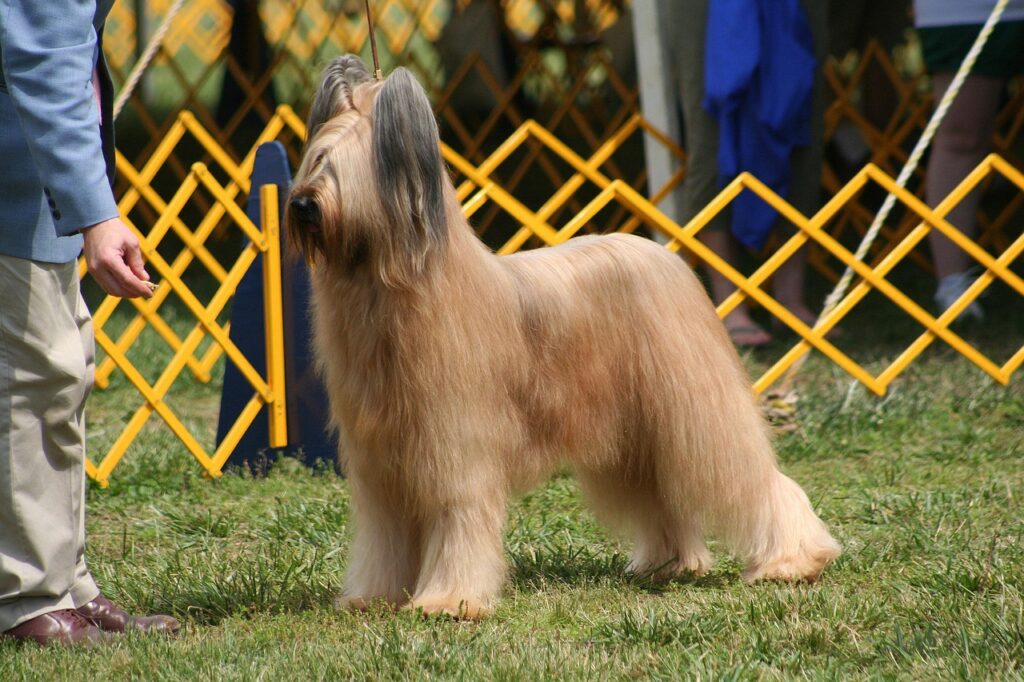
The Briard is part philosopher, part protector, and fully committed to doing things right, especially if it was their idea. Ranked #29 in obedience intelligence, this ancient French herding breed was used to guard flocks and lead sheep across rough terrain without constant guidance. At 55 to 100 pounds, the Briard is muscular, covered in a wavy double coat, and equipped with both a sheepdog’s agility and a seasoned decision-maker’s judgment.
They’re quick learners, typically mastering commands in under 15 repetitions, but also highly discerning. Briards aren’t fans of busywork; they want to know a task has purpose. Their intelligence shines in complex problem-solving and emotional attunement, often placing them in search-and-rescue and therapy work. One Briard famously served in World War I, locating wounded soldiers and carrying supplies under fire. Loyal, intuitive, and fiercely independent, they’re not just obedient but principled. Source: Briard Club of America
28. Belgian Sheepdog (Groenendael)

The Belgian Sheepdog, also known as the Belgian Groenendael, is an elegant black-coated workhorse with serious brainpower beneath all that fur. Ranked #28 in obedience intelligence by Stanley Coren, this breed was developed in Belgium to herd sheep, protect property, and assist with military and police tasks. Weighing 60 to 75 pounds and built for endurance and alertness, the Belgian Sheepdog is lightning-fast in reflex and learning.
They typically master commands in fewer than 10 repetitions and respond with over 85% first-time accuracy. But their intelligence isn’t just about obedience; it’s about interpretation. These dogs are known for reading body language, making split-second decisions, and adapting to complex scenarios. With their loyalty, focus, and protective instinct, Belgian Sheepdogs shine in obedience trials, agility, search-and-rescue, and therapy work. If you’re looking for a thinking dog with a noble presence and nonstop drive, the Groenendael is a velvet shadow with a tactical mind. Source: Belgian Sheepdog Club of America
27. Gordon Setter

The Gordon Setter is the deep thinker of the sporting world. It is steady, loyal, and always calculates the next move. Ranked #27 in obedience intelligence, this Scottish breed was developed to locate and “set” upland game birds by scent, holding position until the hunter arrived. Heavier and more methodical than the Irish or English Setters, Gordons weigh 45 to 80 pounds and are built for endurance over flash, making them ideal for long days in the field and equally thoughtful training sessions.
They typically learn new commands in 10–15 repetitions but process quietly and deliberately. Gordon’s bond deeply with their people and are known for forming long-term memory associations with both environments and commands. They’re also excellent problem-solvers, especially when navigating terrain or tracking scent. Their biddable temperament and calm judgment make them stand out in obedience, hunting, and even therapy work. Don’t expect a people pleaser. Expect a partner. Source: Gordon Setter Club of America
26. Nova Scotia Duck Tolling Retriever

The Nova Scotia Duck Tolling Retriever may be the smallest of the retrievers, but it’s also one of the sharpest. Ranked #26 in obedience intelligence, this Canadian breed was developed to mimic the movements of a fox, enticing curious ducks to come closer to shore, then retrieving them after the shot. Weighing 35 to 50 pounds and wrapped in a vivid red-gold coat with white markings, Tollers are agile, alert, and quick to learn.
They typically pick up new commands in fewer than 10–15 repetitions and love mentally stimulating work. Their ability to switch gears makes them truly impressive: they can go from playful goofball to focused working dog in seconds. Tollers are also emotionally perceptive, often syncing with their owners’ moods and routines with uncanny timing. Their intelligence isn’t just mechanical; it’s adaptive. They don’t just listen; they process, plan, and perform purposefully. Source: Nova Scotia Duck Tolling Retriever Club (USA)
25. Keeshond

The Keeshond is the cheerful philosopher of the dog world, alert, expressive, and always paying closer attention than you think. Ranked #25 in obedience intelligence, this Dutch barge dog was bred to be a loyal companion, watchdog, and symbol of patriotism during political upheaval in the 18th century. Weighing 35 to 45 pounds, the Keeshond sports a thick silver-and-black coat, a foxlike face, and distinctive “spectacles”, markings around the eyes that only add to its wise, observant air.
Keeshonden typically learn new commands in fewer than 15 repetitions and excel in tasks that involve close human interaction. They were bred to live aboard canal boats and warn their people of approaching danger, so their intelligence is rooted in vigilance, emotional awareness, and routine. They’re especially skilled at picking up on tone, rhythm, and subtle daily patterns, often showing up right on cue before you’ve said a word. Their loyalty is deep, their instincts are sharp, and their ability to anticipate your next move is almost eerie. Source: Keeshond Club of America
24. German Shorthaired Pointer

The German Shorthaired Pointer is a high-octane genius with a work ethic that doesn’t quit. Ranked #24 in obedience intelligence, this versatile hunting breed was developed in 19th-century Germany to track, point, and retrieve across water and land. Weighing 45 to 70 pounds, GSPs are muscular, aerodynamic, and wired for motion, and behind that boundless energy is a razor-sharp mind that loves to be put to work.
They typically master commands in fewer than 10–15 repetitions and thrive on structure and challenge. Their intelligence is action-oriented: they’re constantly scanning the environment, solving problems on the fly, and responding with precision. GSPs are known to anticipate hand signals, detect small changes in voice tone, and even self-correct in agility or field trials. But if you don’t give them a job? They’ll make one up, usually involving your laundry. Intelligent, loyal, and always ready to go, they’re not just obedient but overachievers. Source: German Shorthaired Pointer Club of America
23. Brittany

Brittany is an energetic field specialist with a work ethic that rivals any sporting breed. Ranked #23 in obedience intelligence by Stanley Coren, the Brittany (formerly known as the Brittany Spaniel) was developed in France as a bird dog that could point and retrieve, often working closely with hunters in tight, brushy terrain. Weighing 30 to 40 pounds, they’re compact, muscular, and lightning-fast, built for endurance and precision in the field.
Brittanies typically master commands in fewer than 10 repetitions and are known for their enthusiasm, biddability, and deep desire to please. Their intelligence shines brightest when paired with structure, play, and purpose. In field trials, they’re praised for their memory, scenting ability, and responsiveness. Their alert nature and emotional sensitivity make them attentive companions at home, always one step ahead of your next move. Just be warned: without enough stimulation, a bored Brittany will redecorate your house in seconds.
Source: American Brittany Club
22. Irish Water Spaniel

The Irish Water Spaniel is a curly-coated trickster with a brilliant brain and a mile-long comedic streak. Ranked #22 in obedience intelligence, this is the tallest and one of the oldest spaniel breeds, developed in Ireland to retrieve game from land and water with speed, precision, and independence. Weighing 45 to 65 pounds, the IWS is instantly recognizable by its tight curls, rat-like tail, and proud carriage.
They typically master commands in fewer than 15 repetitions and shine in activities that mix problem-solving with physical energy, like agility, dock diving, and advanced obedience work. But they’re not robots. Irish Water Spaniels are thinkers who love to challenge expectations (and your patience). Owners often describe them as “clown geniuses,” dogs that invent games, anticipate routines, and understand context better than many people. Smart, funny, and just a little weird, they’re impossible to overlook. Source: Irish Water Spaniel Club of America
21. Norwegian Elkhound

The Norwegian Elkhound is a silver-coated survivalist with a sharp nose and sharper instincts. Ranked #21 in obedience intelligence, this ancient Spitz breed was developed in Norway to hunt elk and bear in harsh, mountainous terrain. It often works independently, tracking scent for miles and barking to hold large game at bay until the hunter arrives. Weighing 45 to 60 pounds with a thick double coat and curled tail, the Elkhound blends rugged looks with unexpected brainpower.
Though not flashy in traditional obedience drills, Elkhounds typically learn commands in 10–15 repetitions and are especially good at solving problems and reading environments. They’re intuitive decision-makers who excel when trusted, not micromanaged. While they might not break records in speed trials, they’re masters of situational awareness, memory, and loyalty, often forming deep bonds with one person and quietly watching over the rest. Intelligent, steady, and independent, the Elkhound thinks before acting and never forgets what it’s learned. Source: Norwegian Elkhound Association of America
20. Flat-Coated Retriever

The Flat-Coated Retriever is the eternal optimist of the sporting world, joyful, clever, and always up for anything. Ranked #20 in obedience intelligence by Stanley Coren, this breed was developed in 19th-century Britain to retrieve waterfowl and upland game. Similar in build to a Golden Retriever but with a sleeker frame and long, glossy black or liver coat, Flat-Coats weigh 60 to 80 pounds and bring equal parts brains and exuberance to every task.
They typically pick up commands in fewer than 10–15 repetitions and are known for their excellent memory and adaptability in the field. Their intelligence leans heavily on emotional attunement; they thrive on praise, connection, and fun. Flat-Coats do best with upbeat, varied training that keeps them mentally engaged, and they’re stars in agility, rally, and scent-based work. They’re sometimes called the “Peter Pan” of retrievers, not because they don’t grow up, but because they bring endless curiosity and enthusiasm to every moment. Source: Flat-Coated Retriever Society of America
19. Collie

The Collie is as brainy as it is beloved. Made famous by Lassie, it is revered by trainers for much more than Hollywood tricks. Ranked #19 in obedience intelligence, the Collie was developed in Scotland to herd sheep across rough terrain and respond instantly to whistle or voice commands from long distances. Weighing 50 to 75 pounds, Collies come in Rough-coated (long-haired) and Smooth-coated versions, but both share the same remarkable mind.
They typically master commands in fewer than 10 repetitions and are primarily known for their ability to understand nuanced instructions, body language, and even tone. Many Collies are described as having an almost “parental” awareness; they monitor their humans, notice changes in routine, and often react before you ask. Calm, alert, and intuitive, Collies aren’t just obedient, they’re emotionally tuned in. If you want a dog who can think on its feet and read the room like a therapist, this is your star. Source: Collie Club of America
18. Standard Schnauzer

The Standard Schnauzer is the scrappy middleweight of the working group, clever, fearless, and always two steps ahead. Ranked #18 in obedience intelligence by Stanley Coren, this breed originated in Germany as a versatile farm dog: part ratter, part guard, part family companion. Weighing 30 to 50 pounds, they’re distinguished by their wiry coat, expressive eyebrows, and iconic beard, but their brainpower makes them unforgettable.
Standard Schnauzers typically learn new commands in fewer than 10–15 repetitions and retain them with sharp precision. They’re intuitive problem-solvers, highly adaptable, and fiercely loyal to their families. Often described as having a “human-like” personality, they question routines, read emotional shifts, and thrive when treated like a teammate. Smart, vocal, and always thinking, this is a breed that doesn’t just follow commands; it double-checks your logic first. Source: Standard Schnauzer Club of America
17. American Eskimo Dog
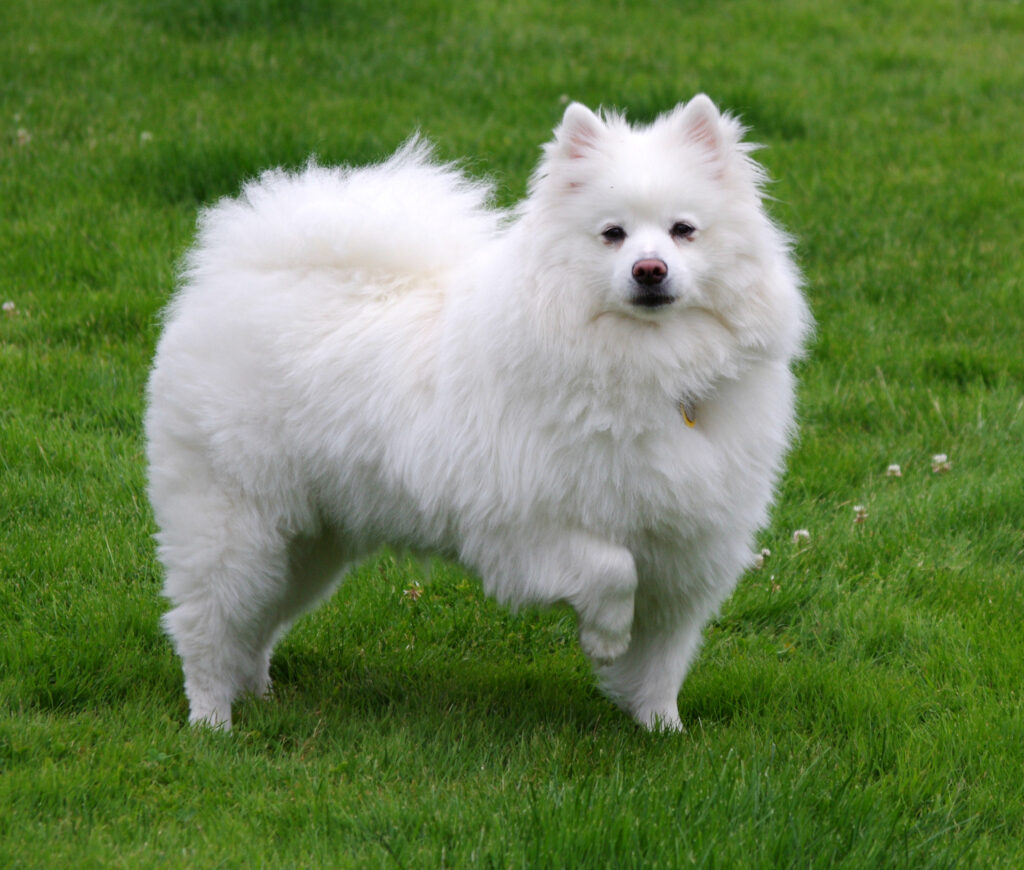
The American Eskimo Dog is a snow-white show-off with serious smarts under all that fluff. Ranked #17 in obedience intelligence, this breed was initially developed in Germany as part of the Spitz family. It later gained fame in the U.S. as a circus performer because it’s good at learning, memorizing, and dazzling crowds. Eskies are alert, agile, and always watching. They are available in toy, miniature, and standard sizes (ranging from 6 to 35 pounds).
They typically learn new commands in fewer than 5–10 repetitions and love having a mental challenge. Eskies thrive in agility, trick training, and advanced obedience, not just because they’re bright, but because they want to show you they’re bright. But don’t let the cute factor fool you: without proper stimulation, they’ll outsmart your routines, find their entertainment, and start managing you. This is a dog that learns fast and expects you to keep up. Source: American Eskimo Dog Club of America
16. English Springer Spaniel

The English Springer Spaniel is a tireless worker wrapped in feathery ears and boundless enthusiasm. Ranked #16 in obedience intelligence, this breed was developed in England to flush game from thick brush and retrieve it, often across unpredictable terrain and under pressure. Springers weigh between 40 and 50 pounds and are athletic, agile, and wired for responsiveness. They thrive in structured environments and are among the few sporting dogs equally suited for fieldwork and obedience competition.
They typically learn new commands in under 15 repetitions and consistently retain them. English springers are emotionally tuned in and known for adjusting their behavior to match the energy of their handler. They are focused in the field, gentle with children, and alert without being reactive. They’ve also excelled in search-and-rescue work and scent detection, thanks to their eagerness to work and natural problem-solving instincts. With the right mix of praise and purpose, the Springer becomes less of a student and more of a teammate. Source: English Springer Spaniel Field Trial Association
15. Pomeranian

The Pomeranian is a pint-sized firecracker with a surprisingly massive brain. Ranked just outside the Top 20 in Stanley Coren’s obedience intelligence list, this toy Spitz breed punches well above its weight when it comes to learning, problem-solving, and performance. Bred down from larger sled-pulling ancestors in the Pomerania region of Europe, the modern Pom weighs in at 3 to 7 pounds, but don’t let that fluff fool you. Behind those alert eyes is a dog that learns commands in under 10 repetitions and performs with theatrical flair.
Pomeranians thrive on attention and mental stimulation. They’re fast learners who excel in tricks, agility, and even obedience routines—often with a touch of dramatic flair. They’re also highly attuned to their humans, reading moods and routines with uncanny precision. Queen Victoria popularized the breed in the 1800s, and Poms have been stealing spotlights ever since. Whether acting as a pocket-sized watchdog or dazzling a crowd with a dance routine, the Pomeranian isn’t just cute, it’s cunning.
Source: American Pomeranian Club
14. Puli

The Puli is a corded genius wrapped in dreadlocks and determination. Ranked #13 in obedience intelligence, this Hungarian herding breed was developed to control sheep on the vast plains known as the Puszta. With a weight range of 25 to 35 pounds and a naturally forming coat of woolly cords that repel water and protect against harsh weather, the Puli doesn’t just stand out visually; it thinks fast, reacts faster, and thrives on having a job to do.
They typically master commands in fewer than 10 repetitions and respond with sharp precision, especially when paired with consistent, task-oriented training. Pulis are light on their feet, famously agile, and often excel in agility, herding trials, and advanced obedience. But it’s not just about following instructions; they anticipate, strategize, and usually act before you finish your sentence. Their loyalty is fierce, their brains are fast, and they’ll herd your kids, your guests, and even your furniture if you don’t give them something better to do. Source: Hungarian Puli Club of America
13. Miniature Poodle

The Miniature Poodle is pint-sized precision in a designer package. Though often overshadowed by the Standard Poodle, this mid-size version shares the same brainpower and ranks just as high in Coren’s obedience intelligence studies. Developed in France and Germany for water retrieving and circus performance, Miniature Poodles were bred to be athletic and highly responsive. Weighing 10 to 15 pounds, they bring elegance, energy, and a terrifying ability to read your mind.
They typically master commands in under five repetitions and remember them with laser-like consistency. What sets Miniature Poodles apart is their balance: they’re playful but focused, emotionally intuitive but fiercely analytical. They adapt to your routine and can easily learn advanced tricks, scent games, or therapy work. And they love to show off often to prove they’re more intelligent than the rest of the room. If intelligence is performance under pressure, the Mini Poodle’s doing calculus in a bow tie. Source: Poodle Club of America
12. Miniature Schnauzer

The Miniature Schnauzer is a whip-smart, bearded dynamo wrapped in charm and confidence. Stanley Coren, ranked #12 in obedience intelligence, developed this compact German breed by selectively downsizing the Standard Schnauzer to create a small but mighty farmhand and ratter. Weighing between 11 and 20 pounds, the Mini Schnauzer is known for its expressive eyebrows, wiry coat, and unwavering alertness. But beneath the trademark beard is a sharp mind that craves stimulation and thrives on challenge.
They typically master new commands in fewer than five repetitions and respond with near-perfect accuracy. Miniature Schnauzers excel in obedience, agility, trick routines, and scent detection, often outperforming larger breeds in focus and finesse. What sets them apart is their blend of curiosity, emotional perceptiveness, and big-dog confidence in a small frame. They anticipate routines, understand tone shifts, and often act like little detectives, solving problems and outmaneuvering distractions. Fiercely loyal and always thinking, this is a breed that doesn’t just obey, it outsmarts. Source: American Miniature Schnauzer Club
11. Pembroke Welsh Corgi

The Pembroke Welsh Corgi is a low rider with high-level cognition. Ranked #11 in obedience intelligence, this herding breed was developed in Wales to move cattle with surprising speed, nipping heels and reading herd movement with uncanny precision. Weighing just 24 to 30 pounds, Corgis may be short in stature, but they pack a strategic brain that’s always in motion. Their fox-like expressions and bold personalities make them both lovable and commanding.
Corgis typically learn new commands in fewer than 10 repetitions and retain them with 85% or better first-time accuracy. Their intelligence shows up in daily routines, they anticipate schedules, respond to subtle cues, and often react before you’ve said a word. Emotionally perceptive and endlessly alert, they’re ideal companions for families who want a sharp, affectionate, and witty sidekick. Small body, massive brain—and enough sass to herd your entire household. Source: Pembroke Welsh Corgi Club of America
10. Australian Cattle Dog

The Australian Cattle Dog is grit, grit, and more grit packed into a sleek, muscular body. Ranked #10 in obedience intelligence by Stanley Coren, this breed was developed to herd stubborn cattle across the wild Australian outback terrain that demanded independent thinking, calculated risk, and unwavering stamina. Weighing 35 to 50 pounds, the Cattle Dog is a master of strategy, often described as the chess player of the herding group. It’s not just obedient, it’s tactical.
This breed typically learns new commands in fewer than five repetitions and responds with over 95% first-time accuracy. But beyond obedience trials, the Australian Cattle Dog excels in real-life problem-solving: anticipating movement, managing chaos, and reacting faster than most breeds can blink. With deep loyalty and eyes that never miss a move, this dog thrives on being challenged and will absolutely challenge you back. Source: Australian Cattle Dog Club of America
9. Papillon

The Papillon is a five-pound marvel with a 500-watt brain. Ranked #9 in obedience intelligence, this toy breed was once the preferred companion of European nobility, but don’t let its dainty looks fool you. Behind those butterfly-shaped ears is a brain that absorbs commands in fewer than five repetitions and performs them with near-perfect accuracy. Light on its feet and lightning fast in its thinking, the Papillon routinely dominates agility, rally, and trick competitions against breeds three times its size.
This is a dog that learns for the joy of it. Papillons crave mental stimulation and thrive when engaged with complex tasks, often linking multiple behaviors into seamless routines. Their intelligence is as emotional as technical; they read tone, mood, and body language with uncanny precision. Described by trainers as “alarmingly smart,” they’re ideal for owners who love teaching tricks or competing, but be warned: this little dog is usually two steps ahead of you. Source: Papillon Club of America
8. Rottweiler

The Rottweiler is a powerhouse of intellect and instinct. Stanley Coren was ranked #8 in obedience intelligence. This German breed was originally developed to herd cattle, pull carts, and guard valuable goods without constant supervision. Weighing 85 to 130 pounds, Rottweilers pair brute strength with emotional awareness, capable of reading subtle shifts in tone, posture, or even a stranger’s intent. They typically master new commands in fewer than five repetitions and obey the first time with over 95% accuracy.
This breed shines in real-world applications. Rottweilers are used in police work, search-and-rescue, service dog roles, and advanced protection training for their physical strength, sharp decision-making, and nerve. They’re exceptionally loyal to one person and require a confident, calm handler. But with that trust comes unshakable devotion and the rare ability to assess threats and act without panic. A Rottie doesn’t just listen, it analyzes. Source: American Rottweiler Club
7. Labrador Retriever

The Labrador Retriever is America’s sweetheart and an undisputed brainiac. Ranked #7 in obedience intelligence by Stanley Coren, Labs are famously friendly, but beneath that wagging tail is a workhorse with remarkable learning speed. Bred in Newfoundland to retrieve fishing nets and later refined in England as a gun dog, Labs are masters of multitasking tracking scent, retrieving game, detecting explosives, or comforting as therapy dogs. They typically learn commands in under five repetitions and respond with near-perfect first-time accuracy.
Weighing 55 to 80 pounds and available in yellow, black, or chocolate, Labs are celebrated for their trainability, patience, and problem-solving skills. They’re the top choice for guide dog programs worldwide, dominating competitive obedience and agility. But what truly sets them apart is their emotional IQ. They bond deeply, read the room instantly, and adapt to nearly any situation. Labs aren’t just easy to train—they’re eager to collaborate. Source: Labrador Retriever Club, Inc.
6. Shetland Sheepdog
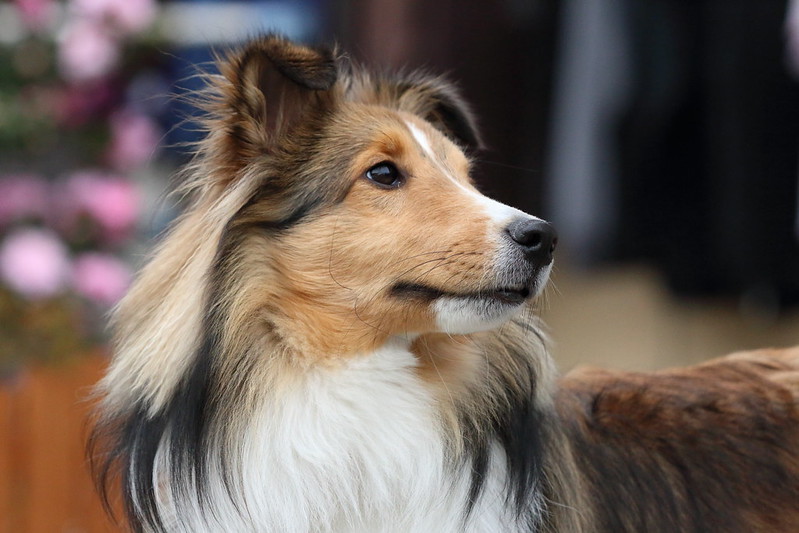
The Shetland Sheepdog, affectionately called the Sheltie, is like a miniature Border Collie in both looks and brainpower. Ranked #6 in obedience intelligence by Stanley Coren, this herding breed from the Shetland Islands of Scotland is a lightning-fast learner with a photographic memory for routines. Originally bred to manage sheep on rocky, wind-blown terrain, Shelties were prized for their precision, responsiveness, and ability to make independent decisions in complex environments.
They typically master new commands in fewer than five repetitions and retain them with near-perfect accuracy. Weighing just 15 to 25 pounds, the Sheltie packs immense intelligence into a compact, agile frame. They excel in competitive obedience, herding trials, and therapy work, often picking up on subtle cues and emotional shifts before their humans do. Sensitive, loyal, and shockingly intuitive, Shelties aren’t just eager to please; they’re often one step ahead of you. Source: American Shetland Sheepdog Association
5. Doberman Pinscher

The Doberman Pinscher is built like a sports car and thinks like a strategist. Ranked #5 in obedience intelligence by Stanley Coren, this breed was originally developed in late 19th-century Germany by a tax collector named Louis Dobermann, who needed a loyal, agile guard dog. The result? A sleek, muscular canine weighing 60 to 100 pounds, known for its lightning reflexes and laser-sharp focus.
Dobermans typically master new commands in fewer than five repetitions and obey them with over 95% first-time accuracy. But it’s not just about speed; they process complex commands with nuance and display emotional intelligence that rivals service breeds. They’ve excelled in police work, military roles, and personal protection not only because of their power but also because they think fast, stay calm, and adapt quickly. Smart, fearless, and elegant, the Doberman isn’t just trainable; it’s tactically brilliant. Source: Doberman Pinscher Club of America
4. Golden Retriever

The golden retriever is the valedictorian of charm, friendly, eager, and undeniably brilliant. Stanley Coren ranked it #4 in obedience intelligence. This Scottish-born breed was developed in the 19th century to retrieve waterfowl with a soft mouth and a willing heart. Weighing 55 to 75 pounds and wrapped in a luscious golden coat, goldens combine physical grace with exceptional cognitive skills and a near-obsessive desire to please.
They typically learn new commands in fewer than five repetitions and obey them with over 95% accuracy. But what truly sets them apart is their emotional intelligence. Golden Retrievers are famously intuitive, often sensing mood shifts, stress levels, and unspoken needs. They’re favorites for therapy work, guide dog training, and search-and-rescue missions. Whether learning complex task chains or offering a head on your lap at the right moment, Goldens prove that intelligence comes from empathy, memory, and unstoppable enthusiasm. Source: Golden Retriever Club of America
3. German Shepherd

The German Shepherd is the Einstein of utility, brilliant, loyal, and born to serve. Stanley Coren, ranked #3 in obedience intelligence, developed this breed in late 19th-century Germany by Captain Max von Stephanitz, who envisioned the perfect working dog. Weighing 50 to 90 pounds, German Shepherds are the ultimate multi-hyphenates: herders, protectors, sniffers, guides, and even movie stars. Their physical power is matched only by their mental dexterity.
They typically master commands in under five repetitions and obey with near-perfect accuracy. But more than just fast learners, German Shepherds are analytical thinkers, able to detect changes in routine, assess threats, and adjust their behavior in real-time. They’re the go-to choice for police, military, and service work, not just for their brawn, but for their composure and problem-solving skills under stress. Calm, courageous, and calculating, the German Shepherd doesn’t follow orders; it understands why you gave them. Source: German Shepherd Dog Club of America
2. Standard Poodle
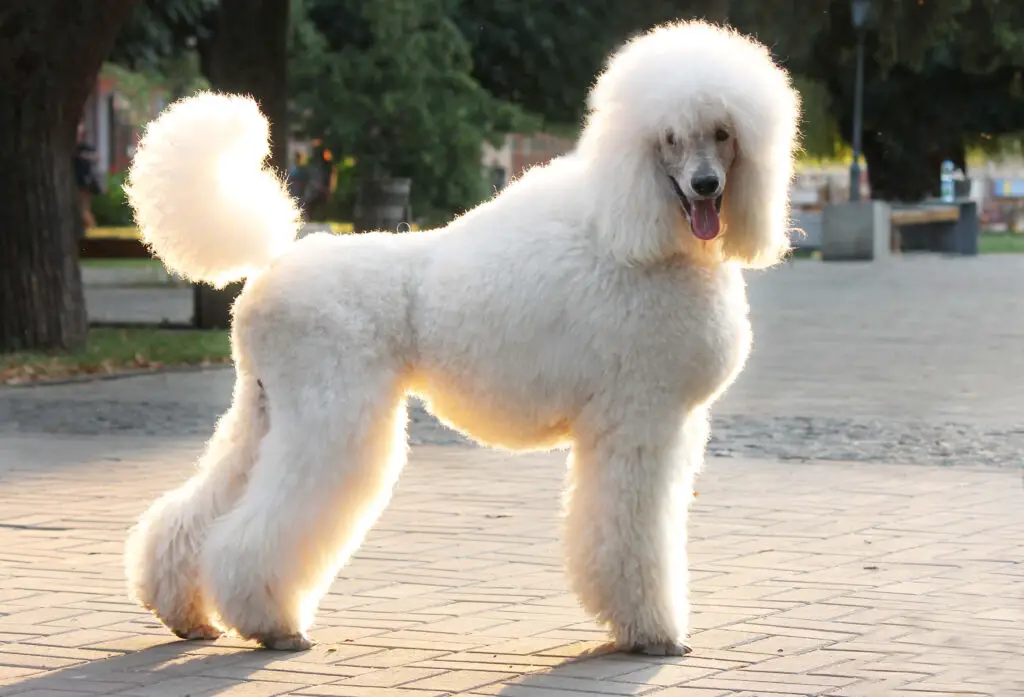
The Standard Poodle is a stylish savant, regal in appearance, razor-sharp in intellect. Ranked #2 in obedience intelligence by Stanley Coren, this French-born water retriever is often underestimated due to its show-ring glam, but underneath the pompadour is one of the fastest-learning, most emotionally attuned breeds in the canine kingdom. Weighing 40 to 70 pounds, Standard Poodles were bred for athleticism and trainability, and they deliver both with flair.
They typically master new commands in fewer than five repetitions and respond with over 95% accuracy. But their intelligence is multidimensional: they excel in obedience, agility, scent work, service roles, and even problem-solving games. Standard Poodles are quick to read emotions, adapt to new situations, and anticipate their humans’ needs. With their blend of elegance, empathy, and elite cognition, they’re the true renaissance dogs, equally at home in a field trial or on a velvet settee. Source: Poodle Club of America
1. Border Collie

The Border Collie is, without question, the reigning genius of the dog world. Ranked #1 in obedience intelligence by Stanley Coren, this Scottish-English herder is a living lightning bolt of focus, energy, and brainpower. Bred to manage sheep with precision and autonomy, Border Collies weigh 30 to 45 pounds but operate like four-legged strategists, capable of memorizing commands, signals, and even choreographed routines in fewer than five repetitions.
Their intelligence goes beyond obedience. Border Collies can anticipate human behavior, detect tiny changes in movement or posture, and solve complex tasks that rival the skills of primates. One Border Collie named Chaser famously learned over 1,000 words and could categorize and retrieve toys by name, function, and category. But brilliance comes with a price: Border Collies can become anxious or destructive without stimulation. This dog needs a job, a puzzle, or a partner who can match its mind. Source: Psychology Today – Chaser the Border Collie
Who’s a Smart Dog Now?

From the contemplative Afghan Hound to the lightning-fast Border Collie, this list proves that canine intelligence wears many faces, and not all of them sit on command. Some dogs shine in obedience trials. Others in problem-solving, herding, agility, emotional intuition, or nose work. And sometimes, the cleverest dogs are the ones who figure out how to get out of their crates when you’re not home.
It’s worth noting: this list follows Stanley Coren’s groundbreaking studies in obedience intelligence, but it doesn’t cover every kind of smarts. Many brilliant breeds didn’t make the cut, like the Belgian Tervuren, Barbet, or Giant Schnauzer, or were ranked the same as close cousins and grouped accordingly, like the English and American Cocker Spaniels or the Bullmastiff and English Mastiff.
Obedience doesn’t equal genius. And genius doesn’t always behave. So if your dog didn’t make the top 60, don’t worry, chances are, they’re still bright enough to have you trained.
Think your pup was unfairly left off the list? Or want to brag about how your dog just figured out how to open the fridge? We want to hear it. Drop us a line, send a photo, or share your best “outsmarted by my dog” story.


